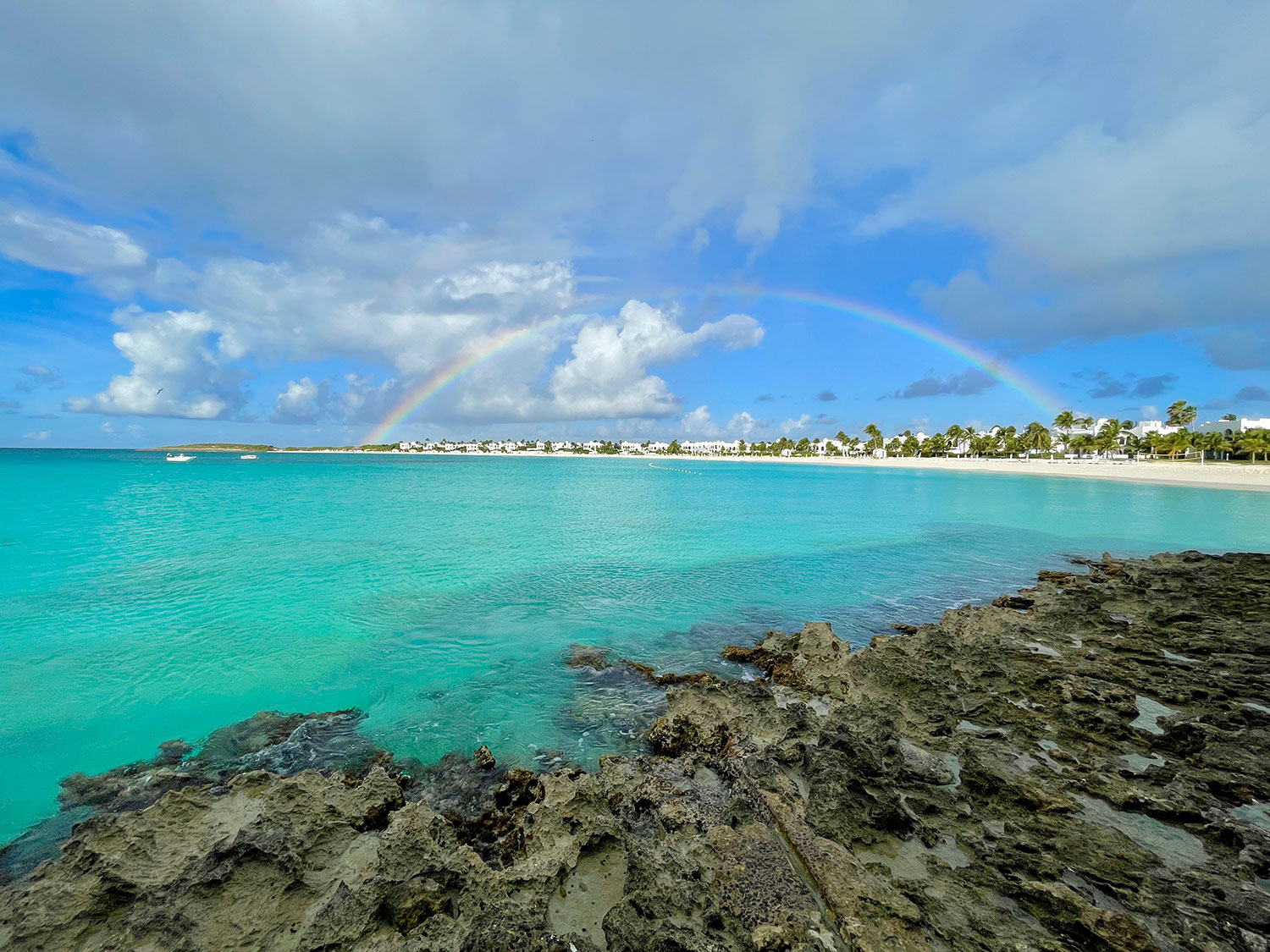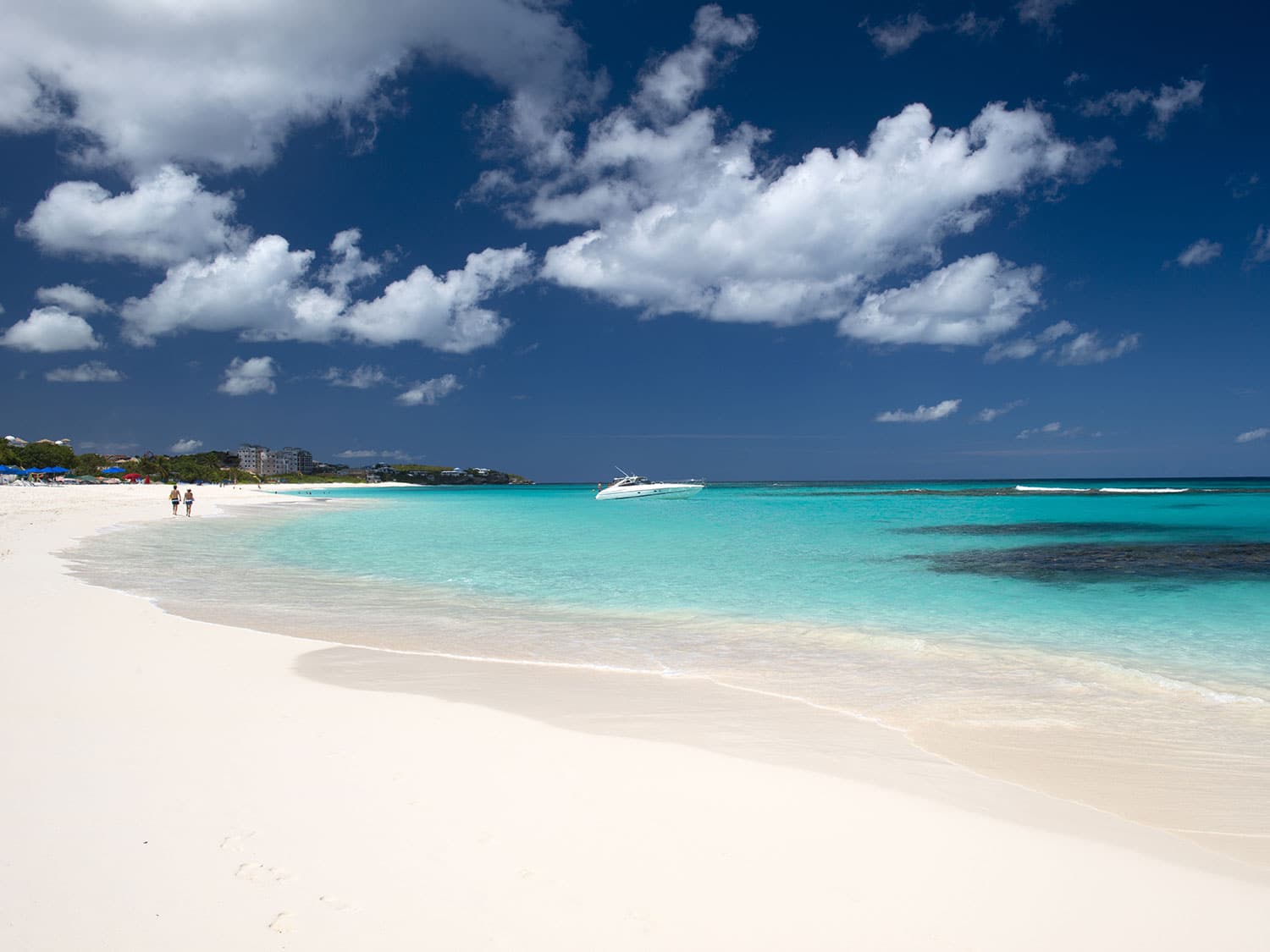Everything You Need To Know About Visiting Anguilla Right Now
Visiting some of the Caribbean’s most beautiful beaches comes with a lot of requirements and responsibilities—but it’s worth it.
With 33 sandy sweeps, luxurious hotels and villas, and an impressive clutch of restaurants, the 35-sq. mi. Caribbean island of Anguilla is a sun-seekers dream. And as the Covid-19 vaccine roll-out begins, it's a dream we're having more often. Open to international visitors since November, Anguilla has instituted rigorous entry protocols which, so far, have managed to keep the virus at bay and position the island as one of the region's safer travel destinations.
If Anguilla's on your 2021 vision board, here's everything you need to know to plan a trip and the skinny on what it's like when you get there.
Anguilla is currently COVID 19-free
Last March, the island recorded three coronavirus cases and subsequently closed its borders. The government's swift action prevented community spread within its population of 16,000 so effectively that Anguilla was the only Caribbean island to hold its summer Carnival. The World Health Organization declared the island officially COVID 19-free in June, and since its reopening last November, only 13 cases have been recorded, all of them caught on arrival.
The CDC currently classifies Anguilla as a Level 1 – Low Risk destination, and, to date, there have been no recorded deaths from the coronavirus.
You’ll need a travel visa
As is the protocol with all Caribbean countries, travelers must apply for travel authorization to visit Anguilla, and the island recommends applying seven days in advance. You'll need to show proof of a negative COVID-19 test result within five days of arrival, and that you have medical insurance that covers COVID-19-related costs. Prospective visitors apply online.
There are three tiers of visas—valid for stays of up to five days, 90 days, or a year—and you can apply as an individual, couple, or family. Current fees start at $300 per person for a stay shorter than five days and escalate to $3,000 for a year-long stay for a family of four.
Fees include the cost of on-island monitoring and two PCR tests, one administered on arrival, the other at your hotel or villa, either near the end of your quarantine or the end of your trip—a boon for U.S.-bound returnees.
HOT TIP: If you're coming to Anguilla via St. Maarten (most visitors fly into SXM and then take the 30-minute ferry ride over to AXA), you'll also need to apply for travel authorization to enter St. Maarten.
There’s a mandatory quarantine
When you land in Anguilla (either at the Blowing Point Ferry Terminal or the Clayton J. Lloyd International Airport), you'll be given a PCR Covid test, fitted with a quarantine wristband, and transferred to your hotel or villa. Once there, you'll be confined to your room (with no restaurant or beach access) until you get your (hopefully negative) results, in six to 12 hours.
On a recent trip, I had my results within in four hours, just in time for a moonlit beach stroll. Visitors from the United States and other countries deemed high risk must then quarantine for 14 days. But that doesn't mean you spend the next two weeks in your hotel room! Read on to find out why.
Anguilla operates a “bubble system”
How can visitors enjoy the island while minimizing their contact with—and therefore chances of transmitting the virus to—locals? In Anguilla, the answer is the bubble system. Visitors may stay only at Safe Environment Certified or "bubble" hotels and villas (the current list includes Belmond Cap Juluca, Tranquility Beach Resort and Four Seasons, Anguilla), where staff have been trained in pandemic protocols and procedures.
For the next two weeks you can dine exclusively by reservation at bubble restaurants (the list, updated weekly, includes favorites such as Straw Hat, Sandy Island, and Ember), which reserve certain days for quarantining visitors and others for locals, so the two groups never meet. Your hotel or villa manager can also arrange specific approved activities, such as yoga, golf, and diving.
You can't rent a car while you're in quarantine, so your hotel or villa manager will arrange a certified taxi, authorized to take you directly to the restaurant and back, with no spontaneous stops (a necessary but painful procedure for an inveterate shopper like me!). You can enjoy the beachfront at your hotel, but if you want to walk down the beach to another bubble hotel or restaurant, you must be escorted by a friendly "beach warden," who makes sure you don't make any impromptu detours.
Quarantined visitors are expected to wear masks in taxis and all public places except the beach, and to maintain social distance. (Of note: Because there's been no community spread in Anguilla, there's no mask mandate for residents outside the bubble.)
There are bubble neighborhoods
On the southwest coast, a section of the sweep at Meads Bay, stretching from Frangipani Beach Resort north to Carimar Beach Club, has been designated as the Meads Bay Bubble. If you stay in this neighborhood, you're free to walk along the beach beyond your hotel and to visit the other hotels and restaurants within in its limits during your quarantine. The only caveat is that you must be accompanied to and from by the beach warden at your hotel.
Not only does this allow you more freedom of movement, it saves you the cost of taxis, which like most things on Anguilla, can be pricey (think $60 for a five-minute ride.) Over on the island's east coast, you can stay in the Shoal Bay Bubble, which starts at Shoal Bay Villas and ends at the Point, allowing full access to the sandy strip in between.
But not everything is in the bubble
For businesses that rely on tourist dollars to survive, being in the bubble makes economic sense. But for those whose bread and butter is patronage by residents, it's not necessarily worth the certification costs.
So, while popular offshore excursions such as Prickly Pear, restaurants including Blanchards, and the course at CuisinArt Golf Resort & Spa are open for bubble guests on specific days, places such as Elvis' Beach Bar, Garvey's Sunshine Shack, and The Dune Preserve are not in the bubble. If you're staying for less than a couple of weeks, take them off your list.
If you test positive on arrival, here’s what happens
Should you test positive upon arrival (and provided you're asymptomatic) you'll have to isolate—at your own expense—at the hotel or villa where you're holding a reservation. All of the Safe Environment Certified hotels and villas on island are required to set aside at least one room from the rental pool, which is reserved exclusively for arrivals who test positive. There you'll be monitored by medical staff until you test negative or transferred to a hospital, if necessary.
Despite the hurdles, it’s worth it
Although the process is easy and efficient, applying for entry to Anguilla is time-consuming and pricey. Tourism officials recommend applying a week in advance, so forget that spontaneous weekend getaway. Your favorite hotel or villa may not be on the certified list, your favorite restaurant may not be in the bubble, and spas may not open until next year.
However arduous or inconvenient they may seem, these strict pandemic protocols have helped keep Anguillians safe and circumvented the spikes in cases seen in other Caribbean islands when they reopen to foreign visitors. The numbers—16 total cases and zero deaths in the last year—speak for themselves.
And, trust us, after you've applied, tested, arrived, retested, quarantined, and finally sink your feet into the silken sands of Maundays Bay, you'll know it's all been worth it.

